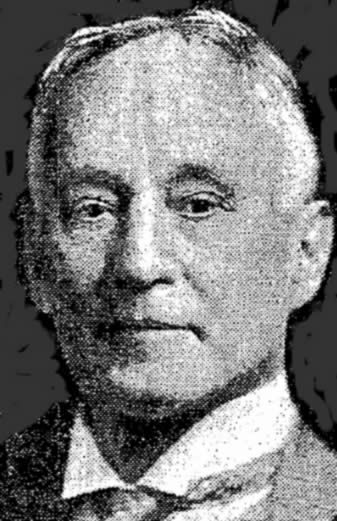The profit Wells made from his Gutenberg Bible venture has not
been publicized, but it helped cement his position in the national and world
spotlight of rare book dealings. Wells's sales methods were unorthodox among
book dealers in that he never issued a catalog of his holdings. His response
to such criticism was that he was in the business to sell books and not to advertise
or catalogue them. However, his methods led some dealers to suspect he manipulated
prices among various clients as well as lacked an in-depth knowledge of the
books he handled. If he did, indeed, lack the knowledge to accurately describe
his holdings, this theory explains his reluctance to put his descriptions in
print. However, his charitable donations led Rutgers University to award him
a Doctorate of Humane Letters.
Wells and the 1899 Editions of Mark Twain's Works
As early as 1919 New York newspapers were reporting on Wells's
presence and purchases at rare book auctions around the city. An April 5,
1919 story in the New York Tribune reported that Wells had purchased
a set of the Writings of Mark Twain on India paper with portraits and illustration
for $239. Two years later the New York Tribune of November 10, 1921
reported that an 1899
autograph edition of the "Writings of Mark Twain" by American
Publishing Company was sold for $610. The 25-volume set was numbered #3 and
formerly owned by Robinson Locke, the eldest son of David Ross Locke who was
known as Petroleum Nasby, one of Mark Twain's colleagues. Although Wells did
not purchase Locke's set of the 1899 edition, he did purchase other items
in that sell and would have been aware of the prices the 1899 uniform edition
of Mark Twain's works was fetching.
Harper and Brothers and Collier and Son Sells Rights to Gabriel Wells
Four months after Wells witnessed the $610 sale of a set of
the 1899 edition of Mark Twain's works, both the New York Times and
the New York Tribune reported that rare book dealer Gabriel Wells had
purchased the rights from Collier and Son to a forthcoming 35-volume set of
Mark Twain's works for $200,000. The edition, to consist of 1,024 sets, would
be called the "Definitive Edition" and would include an autographed
flyleaf from Mark Twain's hand from stock recently discovered in the Harper
and Brothers vaults. The story behind the rediscovery of the autographed sheets
is unclear, but Mark Twain's biographer Albert Bigelow Paine stated that Mark
Twain had signed the sheets in 1906 in anticipation of a new uniform edition
of his works.
The $200,000 price Wells paid for the 1,024 sets was the highest
recorded for any previous author. Newspapers reported that royalties to the
Mark Twain estate would equal more than what the author of a best seller of
that time would received for 100,000 copies. According to The New York
Times, "This royalty, added to the returns on the popular editions
of Mark Twain, makes his earnings, it is said, the greatest recorded for any
author" (The New York Times, 21 March 1922). Why Collier and Son,
who owned the rights from Harper and Brothers to market the subscription sets,
released their rights to the forthcoming autographed edition is unclear but
a quick profit likely figured into the equation.
| Announced in March 1922, the Gabriel Wells Definitive Edition was released
in October 1922. Preliminary material for many of the volumes includes
Appreciations written by prominent authors from around the world. Introductions
were written by Albert Bigelow Paine, Mark Twain's official biographer.
This edition also includes Mark Twain's letters and speeches edited by
Paine and Paine's 4-volume edition of Mark Twain: A Biography.
Albert Bigelow Paine's contributions to the Gabriel Wells edition cannot
be overstated. |
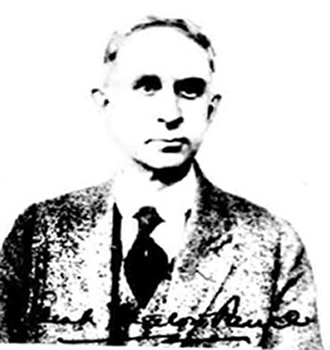
Albert Bigelow
Paine (b. 1861 - d. 1937)
passport photo from 1919 |
The Gabriel Wells Definitive Edition utilizes many of the original
illustrations and engraved portrait frontispieces of Mark Twain that had been
used in the 1899
autographed edition although the artists received no official credit or
acknowledgments. The edition is printed on Old Enfold paper by Plimpton Press
of Norwood, Massachusetts and features a circular "Mark Twain / Samuel
Clemens" watermark. The Gabriel Wells Definitive Edition which was announced
in 1922 was geared to wealthy book buyers and collectors. Three years later,
in 1925, Paine's 2-volume edition of Mark Twain's Autobiography was
added to the set, bringing the total number of volumes for the Gabriel Wells
Definitive edition to 37 making it the edition with the largest number of
titles ever produced for a uniform set of Mark Twain's works.
Gabriel Wells Advertising and Lack Thereof
On October 8, 1922, The New York Times book review section
announced the release of the Gabriel Wells Definitive Edition of 35 volumes
stating that "subscriptions will be received for complete sets only.
... The first hundred sets will be reserved for fine bindings, which will
be executed to order" (The New York Times, 8 October 1922, p.
100). Six months later, an April 1923 ad in The New York Times announced
that only a small number of sets remained unsold.
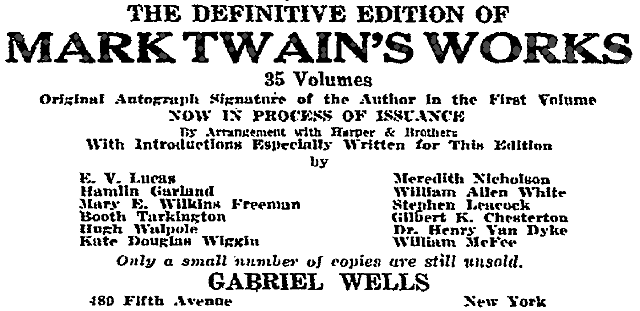
April 29, 1923
ad from The New York Times, p. BR18.
Neither sales prospectus nor advertised sales prices have been
found for the Gabriel Wells Definitive Edition. Given Wells's reputation for
never publishing a catalog of his wares, it is likely his sales were conducted
among elite clients and prices were confidential. However, doing the math
to estimate the minimal prices Wells would have required to break even on
his investment establishes a low cost benchmark. A uniform edition of 1,024
sets with 35 volumes per set totals 35,840 books. Wells was reported to have
paid $200,000 for the edition making the average cost per book $5.58 per book.
Wells's investment per set would be at least $195. Given that Wells had recently
seen an autographed edition of Mark Twain's works sell at auction for $610,
it seems likely that Wells may have attempted to obtain prices that were at
least double his investment.
Features of the Gabriel Wells Definitive Edition
The production of the first 35 volumes of the Gabriel Wells
edition spanned 1922 and 1923. Volumes 1 - 8 bear the copyright date of 1922.
Volumes 9 - 35 bear the copyright date 1923. Volumes 36 and 37 were copyrighted
in 1925. The specially made Old Enfold paper for the edition contained a circular
watermark reading "Mark Twain - Samuel Clemens." However, according
to bibliographer Merle Johnson, Paine's 4-volume Biography which made
up volumes 30-33 was printed on Warren's Oldstyle Paper, the same sheets used
by Harper in their trade edition of those volumes.
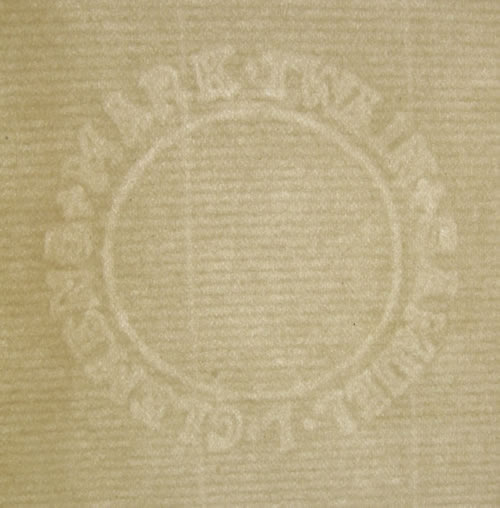
Gabriel Wells
Definitive Edition watermark
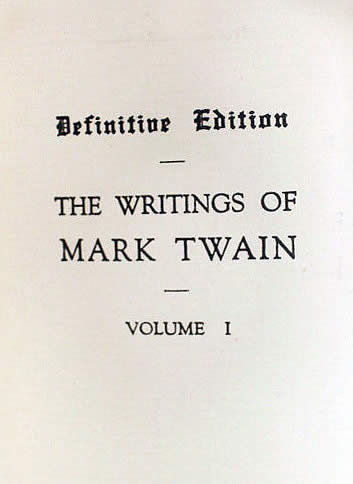
Gabriel
Wells Definitive Edition flyleaf |
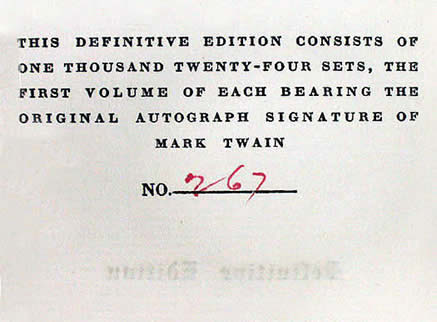
Volume 1
of each set is hand numbered in red ink on the back of the flyleaf. |
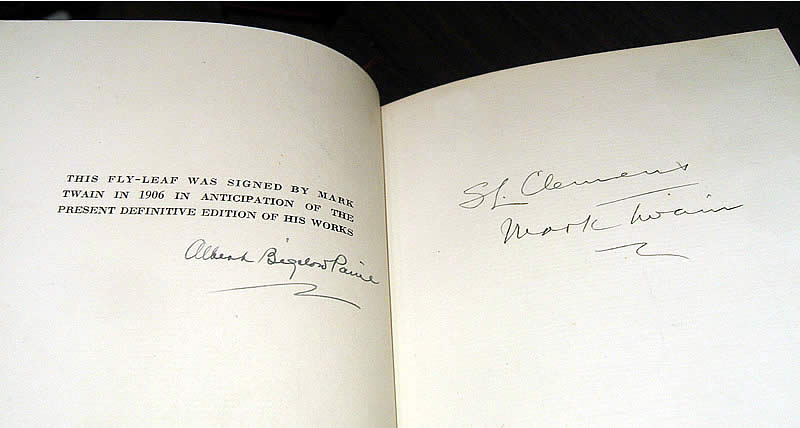
Volume 1 of
each set contains an authentication statement by Albert Bigelow Paine and
the dual autograph of S. L. Clemens / Mark Twain
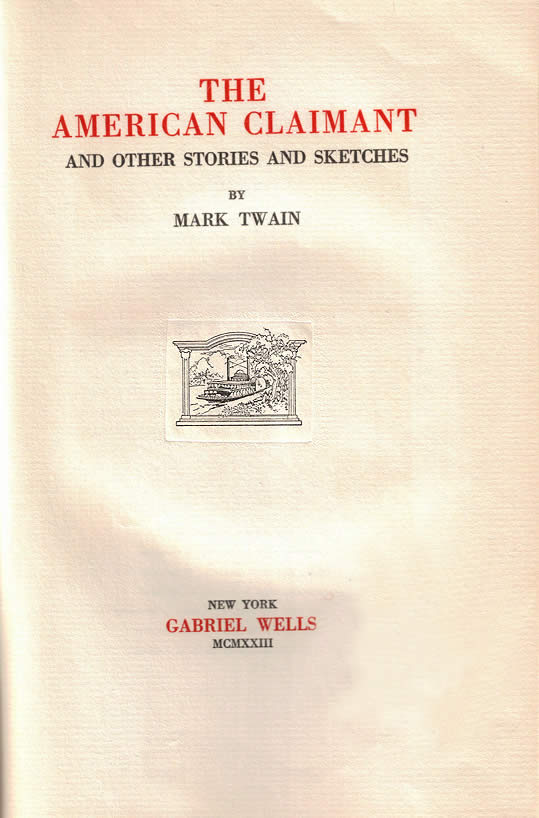
Title pages
feature red and black print along with a tipped in ornament illustration of
a steamboat. The above title page shows the aging and warping of the paper
around the steamboat ornament. Each title page is preceded by a frontispiece
protected by tissue paper.
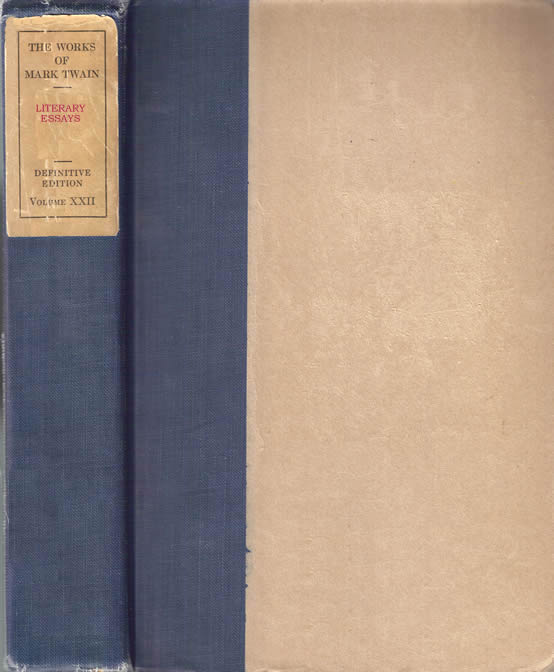
Gabriel Wells
sets are most commonly found in blue cloth and tan boards binding although
elaborate custom bindings were offered. The cloth and board bindings feature
paper labels on the spine. Sets have been found in original plain paper dust
jackets which duplicated the labels on the spine.
Ranking the Gabriel Wells Definitive Edition Against the
1899
American Publishing Company Autograph Edition
The Gabriel Wells Definitive Edition utilized many of the
features and illustrations that Frank Bliss had incorporated into the 1899
Autograph Edition from American Publishing Company. However the Wells edition
does not feature the engraved Tiffany title pages designed by W. H. W. Bicknell.
The Wells edition also fails to identifiy the artists who contributed to
the volumes. In addition, some photographs utilized in the 1899 edition
were not used in the Wells edition. On the positive side of the equation,
the Wells edition utilizes some illustrations that had not been used in
previous uniform editions and it contains more of Mark Twain's works than
had been previously collected in any uniform edition. The edition also contains
unique critical commentary from noted authors of their day regarding Mark
Twain's work.
Summary of Features of Gabriel Wells Definitive Edition
-
Limited to 1,024 sets
-
Autographed flyleaf signed by Mark Twain / Samuel Clemens
-
Autographed flyleaf signed by Albert Bigelow Paine
-
Volumes 1 - 8 copyrighted in 1922
-
Volumes 9 - 35 copyrighted in 1923
-
Volumes 36 - 37 copyrighted in 1925
-
Illustrations protected by tissue guards
-
Cloth as well as custom bindings
-
Circular Mark Twain / Samuel Clemens watermark
-
Some volumes contain Appreciations by noted authors
-
Volumes contain Introduction by Albert Bigelow Paine
-
Shipped with dust jackets
-
Sales prices not advertised
The Volumes and Their Contributors
The Gabriel Wells Definitive Edition was the first multi-volume
edition of Mark Twain's works to number the titles in the approximate chronological
order in which they were first published. The volumes are:
Volumes 1
and 2: The Innocents Abroad. Appreciation
by Edward Verrall Lucas and Introduction by Albert Bigelow Paine
Volumes 3
and 4: Roughing It. Appreciation by Hamlin Garland
and Introduction by Albert Bigelow Paine
Volumes 5 and 6: The
Gilded Age. By Mark Twain and Charles Dudley Warner. Appreciation
by Mary E. Wilkins Freeman and Introduction by Albert Bigelow
Paine
Volume 7: Sketches
New and Old. - Introduction by Albert Bigelow Paine
Volume 8: The Adventures
of Tom Sawyer. Appreciation by Booth Tarkington and Introduction
by Albert Bigelow Paine
Volumes 9 and 10:
A Tramp Abroad - Appreciation by Hugh Walpole and
Introduction by Albert Bigelow Paine
Volume 11: The Prince
and the Pauper - Appreciation by Kate Douglas Wiggin and
Introduction by Albert Bigelow Paine
Volume 12: Life on
the Mississippi - Appreciation by Meredith Nicholson and Introduction
by Albert Bigelow Paine
Volume 13: Adventures
of Huckleberry Finn - Appreciation by William Allen White and Introduction
by Albert Bigelow Paine
Volume 14: A
Connecticut Yankee in King Arthur's Court - Appreciation by Stephen
Leacock and Introduction by Albert Bigelow Paine
Volume 15: The
American Claimant, and Other Stories and Sketches - Introduction by
Albert Bigelow Paine
Volume 16: Pudd'head
Wilson; and, Those Extraordinary Twins - Appreciation by Gilbert K.
Chesterton and Introduction by Albert Bigelow Paine
Volumes 17 and 18:
Personal Recollections of Joan of Arc - Appreciation by Henry
Van Dyke and Introduction by Albert Bigelow Paine
Volume 19: Tom
Sawyer Abroad, Tom Sawyer, Detective, and Other Stories, Etc., Etc.
- Introduction by Albert Bigelow Paine
Volumes 20 and 21:
Following the Equator - Appreciation by William McFee and Introduction
by Albert Bigelow Paine
Volume 22: Literary
Essays - Introduction by Albert Bigelow Paine
Volume 23: The
Man That Corrupted Hadleyburg, and Other Essays and Stories - Introduction
by Albert Bigelow Paine
Volume 24: The
$30,000 Bequest and Other Stories - Introduction by Albert Bigelow
Paine
Volume 25: Christian
Science with Notes Containing Corrections to Date -
Introduction by Albert Bigelow Paine
Volume 26: What
is man? and Other Essays - Introduction by Albert Bigelow Paine
Volume 27: The
Mysterious Stranger, and Other Stories - Introduction by Albert Bigelow
Paine
Volume 28: Mark
Twain's Speeches - Appreciation by William Dean Howells and Introduction
by Albert Bigelow Paine
Volume 29: Europe
and Elsewhere - Appreciation by Brander Matthews and Introduction
by Albert Bigelow Paine
Volumes 30, 31, 32 and 33:
Mark Twain: A Biography by Albert Bigelow Paine
Volumes 34 and 35:
Mark Twain's Letters - Arranged with comment by Albert Bigelow
Paine
Volumes 36 and 37:
Mark Twain's Autobiography - Introduction by Albert Bigelow
Paine
References
"Bibles,"
Time
Magazine,
23 July 1923.
"Book News and Reviews," The New York Times,
8 October 1922, p. 100.
"Gabriel
Wells, 85, Book Dealer Dies," The New York Times, 7 November 1946,
p. 31.
Heartman,
Charles F. Bibliography of The Writings and Speeches of Gabriel Wells,
L. H. D. (Hattiesburg: Miss, The Book Farm, 1939).
Johnson, Merle. A Bibliography of the Works of Mark Twain.
(Harper and Brothers, 1935).
"Mark
Twain Autograph Edition Sold for $610," New York Tribune, 10 November
1921, p. 15.
"Mrs.
Leslie Carter's Books Bring $11,281 at Anderson Galleries Auction," New
York Tribune, 5 April 1919, p.15.
"New Mark Twain Edition de Luxe Brings Top Figure,"
New York Tribune, 20 March 1922, p. 11.
Scott,
Temple. Gabriel Wells, The Philosopher. (The American Collector, 1927).
"$200,000 Mark Twain Set," The New York Times,
21 March 1922, p. 28.
Watkins,
Sue. Personal correspondence, 1 January 2011.
"Wells Will Aids Four Institutions," The New York
Times, 20 November 1946, p. 49.
